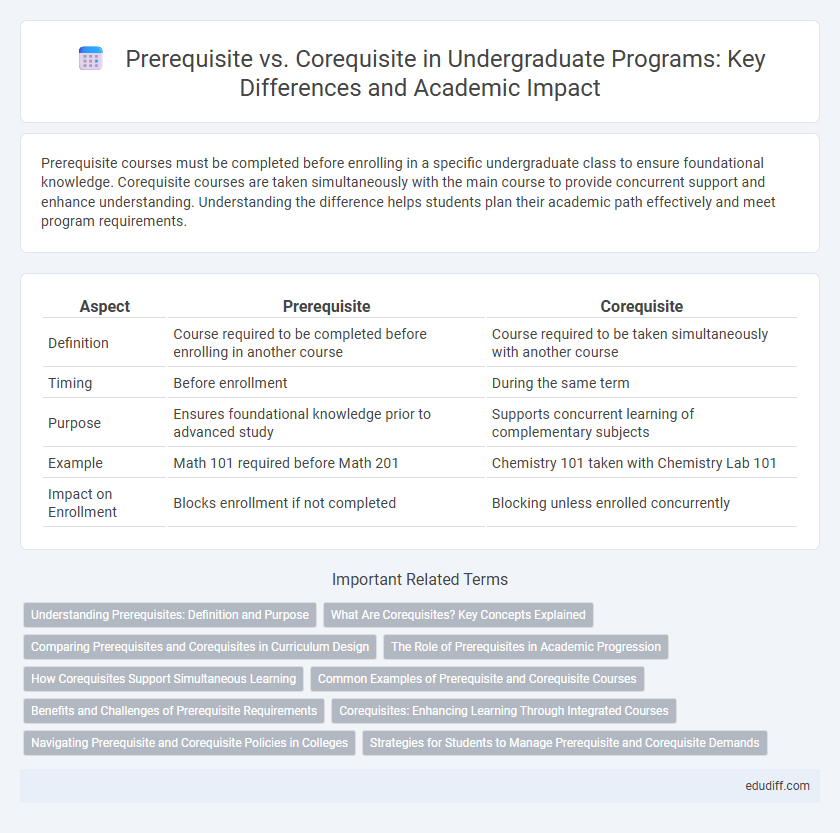Prerequisite courses must be completed before enrolling in a specific undergraduate class to ensure foundational knowledge. Corequisite courses are taken simultaneously with the main course to provide concurrent support and enhance understanding. Understanding the difference helps students plan their academic path effectively and meet program requirements.
Table of Comparison
| Aspect | Prerequisite | Corequisite |
|---|---|---|
| Definition | Course required to be completed before enrolling in another course | Course required to be taken simultaneously with another course |
| Timing | Before enrollment | During the same term |
| Purpose | Ensures foundational knowledge prior to advanced study | Supports concurrent learning of complementary subjects |
| Example | Math 101 required before Math 201 | Chemistry 101 taken with Chemistry Lab 101 |
| Impact on Enrollment | Blocks enrollment if not completed | Blocking unless enrolled concurrently |
Understanding Prerequisites: Definition and Purpose
Prerequisites are required courses or requirements that students must complete before enrolling in a specific undergraduate class, ensuring foundational knowledge and skills are in place. Their purpose is to prepare students adequately for advanced material by building necessary competencies and preventing academic difficulties. Proper understanding of prerequisites helps maintain academic progression and supports student success within degree programs.
What Are Corequisites? Key Concepts Explained
Corequisites are courses that must be taken simultaneously with another course to enhance understanding and academic performance, often designed to complement each other in content and skills. Unlike prerequisites, which are completed before enrollment, corequisites ensure that students engage with essential materials concurrently, promoting integrated learning. This requirement supports complex subject mastery, particularly in fields like science and engineering where theoretical knowledge and practical application are intertwined.
Comparing Prerequisites and Corequisites in Curriculum Design
Prerequisites ensure students acquire foundational knowledge before enrolling in advanced courses, establishing a sequential learning path in curriculum design. Corequisites require simultaneous enrollment in related courses to consolidate understanding and promote integrated skill development. Both strategies optimize academic progression by balancing knowledge acquisition and application within undergraduate programs.
The Role of Prerequisites in Academic Progression
Prerequisites establish foundational knowledge essential for succeeding in advanced undergraduate courses, ensuring students possess necessary skills before enrolling. This structured sequence prevents gaps in understanding and promotes a coherent learning trajectory. Universities leverage prerequisite courses to maintain academic rigor and improve overall student performance by aligning course content with students' prior preparation.
How Corequisites Support Simultaneous Learning
Corequisites enable students to enroll in two interrelated courses concurrently, fostering immediate application of concepts and reinforcing understanding through parallel study. This simultaneous learning structure supports the integration of theory and practice, enhancing cognitive connections and retention. By aligning coursework, corequisites reduce the delay between foundational knowledge acquisition and advanced application, promoting a cohesive academic experience.
Common Examples of Prerequisite and Corequisite Courses
Prerequisite courses often include foundational subjects like introductory mathematics or basic chemistry, required before advancing to higher-level courses such as calculus or organic chemistry. Corequisite courses typically involve courses that must be taken simultaneously, such as enrolling in anatomy lab alongside anatomy lecture or pairing language courses with conversation practice sessions. Understanding these common examples helps students plan their academic pathways effectively, ensuring they meet essential requirements for degree progression.
Benefits and Challenges of Prerequisite Requirements
Prerequisite requirements ensure students acquire foundational knowledge before advancing to more complex coursework, enhancing academic preparedness and success rates. Challenges include limiting flexibility in course scheduling and potentially delaying degree completion for students who struggle with initial requirements. Institutions must balance maintaining rigorous academic standards with accommodating diverse student needs and learning paces.
Corequisites: Enhancing Learning Through Integrated Courses
Corequisites require students to enroll in two or more courses simultaneously, fostering integrated learning by allowing the application of concepts from one course directly into another. This concurrent enrollment supports deeper comprehension and skill development, especially in complex or interdisciplinary subjects such as sciences, engineering, and healthcare. Institutions often design corequisite pairs to reduce remediation time and improve academic performance by ensuring students tackle foundational and advanced material together.
Navigating Prerequisite and Corequisite Policies in Colleges
Colleges require students to understand prerequisite and corequisite policies to effectively plan their course schedules and ensure academic success. Prerequisites are courses that must be completed before enrolling in a subsequent class, while corequisites must be taken simultaneously with the related course. Navigating these policies involves checking college catalogs and advising resources to align course sequences with degree progress requirements.
Strategies for Students to Manage Prerequisite and Corequisite Demands
Effective strategies for managing prerequisite and corequisite demands include creating a detailed academic plan outlining course sequences and deadlines. Prioritizing communication with academic advisors helps clarify requirements and identify potential roadblocks early. Utilizing campus resources such as tutoring centers and study groups supports mastering prerequisite knowledge while concurrently managing corequisite coursework.
Prerequisite vs Corequisite Infographic

 edudiff.com
edudiff.com